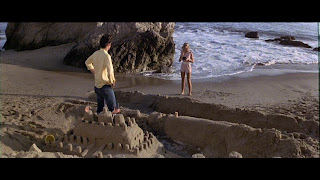Professor Ramirez-Berg introduced a three-act structure that storywriters love to use to develop and end their stories. The three-act structure is a handy structure that has a beginning, middle, and end, also known as an introduction, complications, and resolution to the story. The structure for the first act can be defined as the introduction said Professor Ramirez- Berg. The introduction is used to introduce the characters and their surroundings, taking up about thirty percent of the entire movie, so the viewer can be get a better understanding of the storyline. As the storywriter finishes the introduction of characters he/she will propel action to the next act to imply complications to transition to develop the next act. In doing so, the storywriter spends about sixty-five percent of the movie developing complications and plot points leading up to the climax. According to this three-act structure, the climax is most likely the last five minutes of the film, so about five percent of the rest of the movie. A great example of this three-act structure would be the classic musical Grease.
Introduction (Beginning)- Danny actually tells the guys that he really likes this young lady named Sandy, which is not like him since he suppose to be a guy that sleeps with chicks and not fall in "love".
 Complications (Middle) - Many things happen during this time of the three-act structure, but this is one complications that I would just like to point for reference. Take for example, the young ladies in the film are having a sleep over and talking about the young men, and teases Sandy about her soft heart for Danny. Clearly, give Sandy no choice but to play with his heart or let him play with hers.
Complications (Middle) - Many things happen during this time of the three-act structure, but this is one complications that I would just like to point for reference. Take for example, the young ladies in the film are having a sleep over and talking about the young men, and teases Sandy about her soft heart for Danny. Clearly, give Sandy no choice but to play with his heart or let him play with hers. Resolution (Ending)- So, Sandy decides to change her look to let Danny realize what he could have had. Sandy sings to Danny to push his interest in her by telling him "he better shape up cause she needs a man," not a man who plays childish games.
Resolution (Ending)- So, Sandy decides to change her look to let Danny realize what he could have had. Sandy sings to Danny to push his interest in her by telling him "he better shape up cause she needs a man," not a man who plays childish games.









